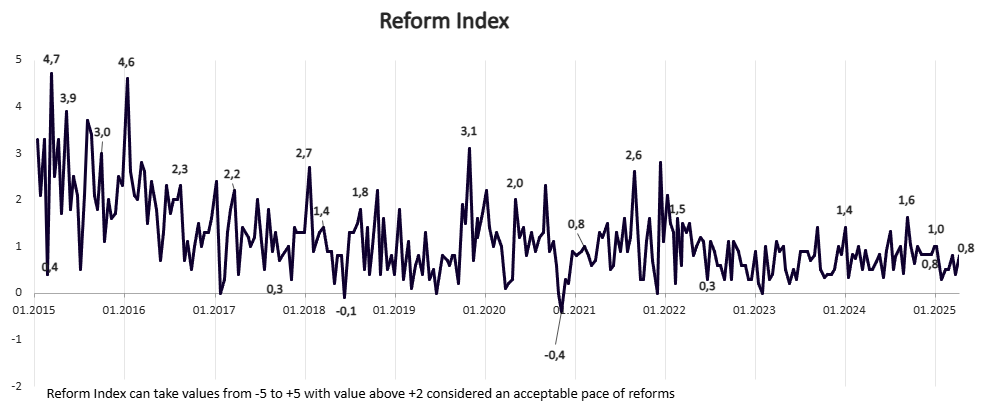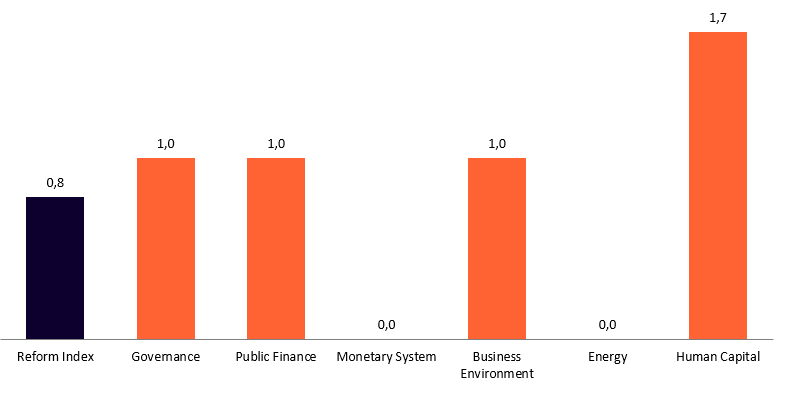Ukraine is making progress in fulfilling its commitments to the IMF and the European Union. On March 24, the President signed a long-awaited law to establish new specialized administrative courts, replacing the dissolved Kyiv District Administrative Court. This reform received a score of +1 (on a scale from -5 to +5) from the Index’s experts.
Between March 14 and April 6, the experts recorded six reforms, each earning a +1 score. Compared to the previous edition, the overall Reform Index doubled and now stands at +0.8 points.
Graph 1. Dynamics of the Reform Index

Graph 2. Values of the Reform Index and its Components in the Current Assessment Round

Establishment of new specialized administrative courts, +1 point
Ukraine will establish two new specialized administrative courts, fulfilling one of the overdue structural benchmarks set by the IMF.
The Specialized District Administrative Court will replace the Kyiv District Administrative Court (OASK), which was dissolved in 2022. The new court will hear cases against central executive authorities (including the Cabinet of Ministers and Ministries), the National Bank of Ukraine, and other nationwide bodies (such as the State Tax Service and anti-corruption agencies). It will also adjudicate matters related to the registration and financing of political parties, as well as the state regulation of media. In accordance with the law, a Specialized District Administrative Court of Appeals will also be established to review decisions made by the Specialized District Administrative Court.
Judges for both courts will be selected through an open competition involving an Expert Council, which will assess candidates’ integrity and professional competence. The Council will be composed of six members: three representatives appointed by the Council of Judges of Ukraine and three nominated by international organizations.
Information about the Reforms Index project, the list of Index experts and the database of the regulations assessed are available here.
Expert commentary
Olena Ovcharenko, Doctor of Law, Judicial Expert at the Centre of Policy and Legal Reform
“The establishment of the Specialized District Administrative Court and the Specialized Administrative Court of Appeals is intended to fulfill one of the key structural requirements set by the IMF and the European Commission. These courts will hold the status of higher specialized courts under Article 125 of the Constitution of Ukraine, serving as courts of first and appellate instance, respectively. Their creation is expected to strengthen the independence and impartiality of this branch of the judiciary, whose reputation was severely damaged by the controversial practices of the now-dissolved Kyiv District Administrative Court. However, the law does not address the unresolved issue of the cases that remained pending following the dissolution of OASK in December 2022. Moreover, the new courts’ jurisdiction is relatively limited, although it is anticipated to be expanded should the new institutions prove effective.
A notable advantage of the law is the expanded pool of eligible candidates. In addition to judges, legal scholars, and attorneys, civil servants with at least seven years of experience in senior civil service positions (categories ‘A’ and ‘B’) will also be eligible to apply.
The selection process will involve an Expert Council composed of three Ukrainian and three international experts, who will assess candidates’ integrity and professional ethics. They will have access to judicial registries and personal files and receive logistical support from the State Judicial Administration of Ukraine. However, there is public concern that international experts will not wield a decisive vote in the selection process, unlike in the procedure for the High Anti-Corruption Court (HACC). A finding of a candidate’s lack of integrity will only be valid if supported by at least two Ukrainian and two international experts.
The law also introduces a legal inconsistency that could call into question the formal status of the new courts as higher specialized courts. Under Part 1 of Article 31 of the Law ‘On the Judiciary and the Status of Judges,’ higher specialized courts may be established as first- and appellate-instance courts for specific categories of cases. However, judging by their names, the new courts could instead be categorized as local courts (Part 1, Article 21) and appellate courts (Part 1, Article 26) under the same law. This inconsistency could have been avoided by following the model of the High Anti-Corruption Court (HACC), a higher specialized court with an Appellate Chamber established to review first-instance decisions.
Despite the pressing need for the swift establishment of the new courts, their operational launch appears to be a distant prospect. The High Qualification Commission of Judges of Ukraine faces significant institutional capacity constraints, as it is already engaged in numerous concurrent recruitment and evaluation procedures—including the qualification assessments of incumbent judges, competitions for positions in local and appellate courts, and the selection of judges for the HACC. Historically, similar competitions have stretched over many months, suggesting that the new administrative courts are unlikely to become fully operational before the second half of 2026.”
Replacing the subsistence minimum with basic social assistance, +1 point
The Cabinet of Ministers is launching a pilot program to overhaul the way assistance is calculated for low-income households.
Currently, social benefits in Ukraine are calculated based on a legally fixed subsistence minimum, which is substantially lower than the actual cost of living—the amount required to meet basic monthly needs. As a result, many social assistance payments remain insufficient. Meanwhile, raising the subsistence minimum is fiscally unfeasible, as a broad range of payments are tied to this indicator.
In the longer term, the government plans to replace the current framework with a new basic social assistance model. For now, however, the pilot program will operate in parallel with the existing subsistence minimum.
Under the pilot program, assistance for certain groups will be calculated based on a fixed amount of UAH 4.500. The government resolution does not provide for indexation of this amount. The level of basic social assistance will be determined as the difference between the fixed sum and a household’s actual average monthly income.
The calculation will also vary depending on household composition: the first family member will be entitled to 100% of the basic amount, and each additional member will be entitled to 70%. A separate provision applies to children under six, children with disabilities, and persons with Group I or II disabilities, who will each receive 100% of the basic amount. Elderly individuals without sufficient insurance contributions will be eligible for a percentage of the basic amount based on their work history: less than 10 years—53% (UAH 2,385), 10 to 20 years—62% (UAH 2,790), 20 to 30 years—70% (UAH 3,150), and more than 30 years—88% (UAH 3,960).
The program is scheduled to launch on July 1, 2025. The initial beneficiaries will include low-income and large families, single mothers and children, and families where one parent evades alimony payments or is unable to provide support for children. Beginning October 1, the program will be expanded to include other vulnerable groups. It will be financed through the state budget under the low-income family support program.
Expert commentary
Yuliia Markuts, Center for Public Finance and Governance Analysis at KSE
“Cabinet of Ministers Resolution No. 371 launches a two-year experimental project to provide basic social assistance. This initiative is part of a broader social policy reform aimed at gradually transitioning from using the subsistence minimum as the basis for calculating social assistance for vulnerable groups to introducing a new basic benchmark amount.
The basic amount is being introduced due to the limited effectiveness of the current subsistence minimum. For many years, the legally established subsistence minimum in Ukraine has failed to reflect the actual cost of meeting basic needs. It has been kept artificially low, resulting in social benefits that are inadequate to meet real living expenses. For example, in 2024, the actual cost of living was 2.7 times higher than the legislatively fixed subsistence minimum. Moreover, because it has not been fully indexed to inflation, its relevance as a real benchmark has been significantly undermined.
In response, the government is introducing the basic amount as a new calculation indicator, independent of the statutory subsistence minimum and determined with reference to the prevailing economic situation. The resolution sets the basic amount at UAH 4,500—approximately 1.5 times higher than the legally established subsistence minimum. This measure is intended to align the calculation of social benefits more closely with the real needs of the population and to ensure a more adequate and evidence-based level of support.
The basic amount will allow for more tailored assistance by taking into account household composition, the age of children, disability status, and other relevant factors. Basic social assistance will not only support low-income families but will also be extended to a broader range of socially vulnerable groups by consolidating several existing programs into a unified system of basic social assistance. It represents a key element in the transition toward a new model of social protection—one that prioritizes targeting, fairness, and the provision of a sufficient level of support.”
Reform Index from VoxUkraine aims to provide a comprehensive assessment of reform efforts by Ukraine’s authorities. The Index is based on expert assessments of changes in the regulatory environment in six areas: Governance, Public Finance, Monetary system, Business Environment, Energy, Human Capital. Information about the Reforms Index project, the list of Index experts and the database of the regulations assessed are available here.
Attention
The author doesn`t work for, consult to, own shares in or receive funding from any company or organization that would benefit from this article, and have no relevant affiliations



